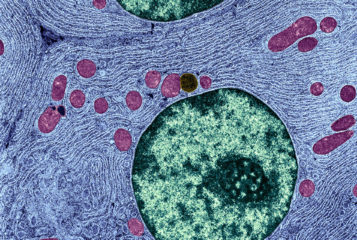'Thirty million volts per metre – like a bolt of lightning.' Energy, electricity, evolution and disease – the mysterious origins of mitochondria are unpacked in this information-rich programme, simply titled Mitochondria, from the series 'In Our Time' on BBC Radio 4.
Melvyn Bragg and his guests chart a course through the mysterious world of mitochondria, steering through conversations on the unlikely discovery, evolutionary origins, and modern understanding of this essential component of our cells. This programme captures the listener's imagination as authoritative guests explore some fairly complex science, giving a great potted history of the topic before arriving at our current understanding of this peculiar organelle.
Bragg opens the programme with an introduction, labelling mitochondria as 'the power-pack of cells', before handing over to Nick Lane, professor of evolutionary biochemistry at University College London (UCL). Professor Lane begins by walking us through how scientists believed mitochondria to be bacteria that invaded other cells, and even tried to culture them as such in the lab, to no avail. While this early concept of mitochondria was not exactly correct, it led to an understanding of their evolutionary journey as bacteria that formed endosymbiotic relationships – living inside another microorganism, providing benefits such as energy production and creating cell structures for the host cell.
Professor Lane explains that because of the different evolutionary paths taken by mitochondria and the host cell, DNA in the mitochondria differs from DNA in the nucleus, with a much smaller mitochondrial genome containing genes related specifically to energy production and cellular structure functions. The consequences of this are discussed in greater detail later in the programme.
Next up is Mike Murphy, professor of mitochondrial biology at the University of Cambridge. Professor Murphy adds another layer of detail, introducing the topic of energy exchange within cells in simple and understandable terms. When questioned on the scale of energy produced by the mitochondria, he explains that the energy produced is continually replenishing within the cell 'like a dynamo system within the body'.
Professor Murphy describes energy production levels of '30 million volts per metre – like a bolt of lightning', which struck me to the extent that I wanted it as the opening line of this review! The use of analogies really brings the scale of mitochondria to life in this programme. Having studied biology myself at both A-Level and Undergraduate level, I couldn't help thinking that dramatic comparisons like this would have been useful during my own studies.
Professor Lane recounts the tragic tale of Richard Altmann, who theorised that mitochondria were one of many 'elementary organisms' organised within cells. Both Altmann and his theory were rejected by the scientific establishment, and he ultimately took his own life. Professor Murphy then describes other aspects of how mitochondria and their role were discovered. All of this historical context adds a great deal of colour to the topic.
The programme really shines when these conversations shift to the modern understanding of mitochondria, and the roles that mitochondria play in addition to powering the cell. Dr Florencia Camus, from UCL, explains how our cells have two different genomes running in tandem – a nuclear genome and a mitochondrial genome – and how the implications of this are becoming more apparent.
Dr Camus describes the 'mother's curse' phenomenon, which has been associated with various diseases. Unlike nuclear DNA, which is inherited from both parents, mitochondrial DNA (mtDNA) is inherited solely via the egg. This can lead to mutations accumulating more easily, leading to mitochondrial diseases and contributing to neurodegeneration, diabetes and diseases of ageing.
Professor Lane explains that mitochondria are now known to play a significant role in cancer development. Because one of the functions of mitochondria is to provide building blocks for cellular structures, their role in cancer is crucial. The uncontrolled cell growth that occurs during cancer development requires large amounts of energy, which mitochondria are essential in providing.
At this point, the experts discuss mitochondrial donation and three-person IVF. When women are known to have mitochondrial mutations that can cause disease in their children, a donor egg - or an embryo created with mitochondria from a donated egg - can be used as a source of healthy mitochondria (see BioNews 1189).
The Human Fertilisation and Embryology Authority recently confirmed the birth of the first child(ren) with donated mitochondria in the UK (see BioNews 1189). This is an incredible example of how our understanding of mitochondria, and ways of addressing problems involving mitochondria, have progressed in the past century. Host, Bragg expressed sufficient credulity throughout the programme, which is definitely warranted here.
Overall, this programme is a very enjoyable round-up of the history and understanding of mitochondria, and how our modern understanding of the function of mitochondria can be used to treat disease. It is pitched at a level that can be enjoyed by many, from layman to experienced biologist, and offers both a great introduction and many avenues to explore. The sometimes dry topic of cell biology is really brought to life in this quick-paced and information-rich programme.






Leave a Reply
You must be logged in to post a comment.